Dolmabahçe palace wasn’t on my list of must see places in Istanbul, I had researched and decided that Topkapi palace would be better, but on our first day we were way ahead of schedule and found ourselves with a few hours to spare after lunch, so we got a taxi from Taksim Square and went exploring.
Sitting along the Bosporus in Beşiktaş, Dolmabahçe is the largest palace in Turkey, with 285 rooms, 44 halls, 68 toilets and 6 Turkish baths. It was built in the Ottoman era, between 1843 and 1856, ordered by Sultan Abdülmecid I. Prior to this, the sultan and his family had lived at Topkapi palace, but this lacked the ‘modern’ luxuries he desired. Dolmabahçe is very grand, with a lot of influence from European palaces – the Queen wouldn’t look out of place here! It has the largest number of Baccarat crystal chandeliers in the world, a crystal staircase, bearskin rugs and beautiful ceilings which they used 14 tons of gold for!
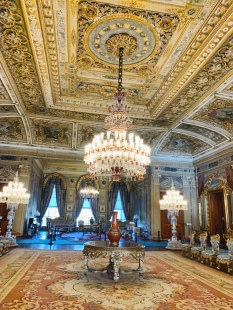
Before I start, I should say that taking photos inside the palace is not allowed, there are signs everywhere and we definitely broke the rules, but the photos are just too impressive not to share. There are security guards with eyes on you, so you have to be really sneaky and prepared to be told off if you get caught (Berkay did!).
When approaching the palace, you are firstly greeted with a huge clock tower, before you arrive at the ticket booths. There are different ticket types, one that one allows entry into the main section of the palace, and a combined ticket that allows entry into the harem section too. We got the combined ticket but as a Turkish citizen, Berkay got it for half the price and we paid 130tl altogether – mine was 90tl of that.




You enter the grounds through an impressive gate – like something out of a fairy tale. Once through the gate, you can see the palace sitting perfectly centred behind a large pond, surrounded by trees and statues. There is also a gate straight into the Bosporus on the right hand side of the palace – handy for boats!
At the palace entrance you are asked to cover your shoes, and there are huge rolls of rather unattractive plastic blue shoe covers for this purpose – I dread to think of how much plastic they get through in a day!


The palace is split into two wings, one is the men’s quarters, with reception rooms for visitors and for official business. This is the part of the palace which was really made for showing off and impressing other countries officials with the luxuriousness of the chandeliers, staircase, furniture and paintings hung on the walls.
I wish I could explain how beautiful the crystal staircase is. You are able to walk up the red carpeted stairs, lined with crystal banisters while the chandelier glistens above. We weren’t able to get a good photo but I felt like I was in Disney movie, a princess walking up the staircase of dreams! If you google ‘crystal staircase at Dolmabahçe’ you can see photos of it.
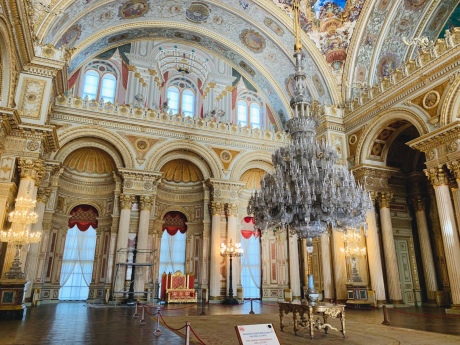

In the ceremonial hall, the world’s largest Bohemian crystal chandelier hangs above you. It has 750 lights and weighs 4.5 tonnes – ouch! Although impressive, with the stunning intricately detailed ceiling above it, it wasn’t my favourite. My favourite was a chandelier in a different room with red crystals – I’m glad Berkay managed to sneak a few good photos of that one.


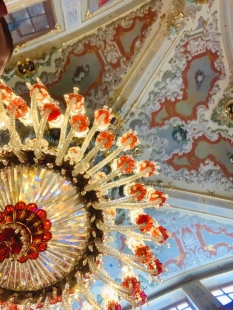
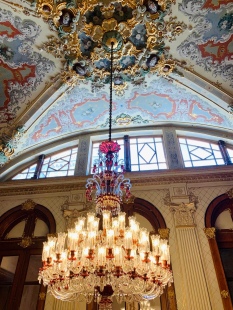
The other wing is the Harem at the back of the palace– which has 8 interconnecting apartments where the Sultan and his family lived – including his wives, concubines (mistresses), mother, and slaves. It’s really interesting thinking what life must have been like for them as you’re walking through. Although not quite as grand as the other wing of the palace, it still has impressive rooms and chandeliers and is definitely worth paying for the extra ticket for.

After the fall of the Ottoman empire, Dolmabahçe Palace became founder of Turkey, Mustafa Kemal Atatürk’s presidential palace, where he spent time during his Istanbul visits. In the harem section, you can find the room that Atatürk died in – there is a sign outside the room informing you of this. The wallpaper is gold, green and peach, with matching curtains and ceiling. The bed has a Turkish flag covering it and the clock in the room is set to the time he died, 9:05am on November 10th 1938. I think the palace has a special place in Turkish people’s hearts for this reason.
In 1984, the palace became a museum, and opened to the public. Hundreds of thousands of tourists visit the palace every year and if you’re in Istanbul you should stop by. You’ll feel like you’re walking through a real life fairy tale palace – and it is totally different to Topkapi (I’ll write about that soon!) so I’m glad we had a chance to visit both.
P.S click on any of the photos above to enlarge them and see them in all their glistening glory!

This will have to go on my list to visit,
It’s so pretty x
Glad you snuck some photos! :p
When Berkay got told off he pretended he was English! haha x
Ha ha, good idea!